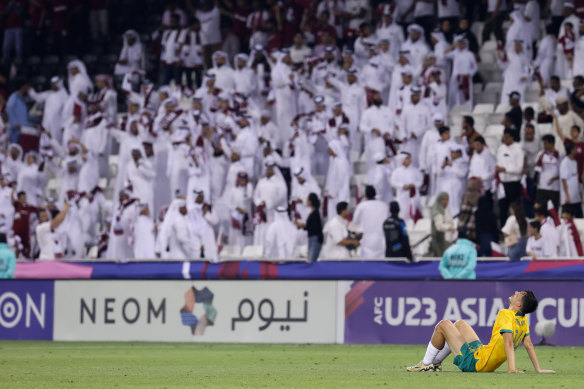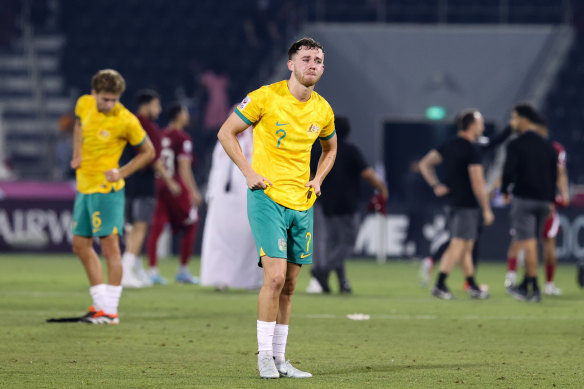By Vince Rugari
To be fair, there were extenuating circumstances.
And you couldn’t really ask for much more in the way of extenuation from this particular set of circumstances: because the under-23 Asian Cup was scheduled outside a FIFA window, Australia were forced to take an essentially second-string squad to Qatar.
You could draw up a pretty strong theoretical starting XI featuring players who were blocked from attending by their clubs, which would include Parma’s Alessandro Circati, Brighton’s Cameron Peupion, and newly capped Socceroo Patrick Yazbek. On-loan Portsmouth whiz Alex Robertson and Marco Tilio, the former holder of the A-League’s all-time outbound transfer record, were injured. And yes, there was one other reasonably talented player overlooked for different reasons, which we’ll come to.
And so Olyroos coach Tony Vidmar deserves a bit of slack for his side’s failure to qualify for the Paris Olympics. But only a bit. This was the sort of disaster that would have taken up a three-hour episode of The World Game on SBS back in the day, and it would have ended with at least one head on a pike, Foster versus Postecoglou style.
Monday morning’s (AEST) 0-0 draw with Qatar was an all-time low for the Olyroos. They’ve fallen at the group stage before at the Asian Cup – in 2016 and 2018, the former under Vidmar’s older brother Aurelio – but they’ve never gone winless, let alone scoreless. Fifty-four shots, zero goals; their opponents had a combined 20, with just four on target. Even if they’d beaten Qatar, they wouldn’t have made it out of the group because of the result in the other game, leaving the Matildas to fly the flag alone for Australian soccer at Paris 2024.
To make matters worse, Tim Cahill was somewhere in the building wearing a QFA blazer.

Nicolas Milanovic reacts to the Olyroos’ scoreless draw with Qatar.Credit: Getty
Australia needed to finish in the top three at the tournament to qualify directly for Paris, which deep down nobody really expected, even though Vidmar declared they were good enough to do it on the eve of their first match. In falling short, they have now made the Olympic Games only once in the last four cycles – and with Graham Arnold routinely stressing the critical link between the junior national teams and the Socceroos, that has to be a serious concern.
It was always going to be tough, but it shouldn’t have been this tough, leaving Doha without so much as laying a glove on any of their opponents. It’s true that Asian football is improving – we hear that all the time, whenever Australian teams fail in Asia – but it’s not improving so rapidly that the Olyroos should simply accept they are inferior to Qatar and Indonesia.
If that’s even remotely true, is anything being done about it? Or is that just how it’s going to be?
Clearly, Australia is developing decent enough players; the transfer market is a good measure of that, and this tournament wasn’t the most accurate reflection because of the aforementioned circumstances. But are we using what we have correctly?

Lachlan Brook struggles to hold back tears after Australia’s elimination.Credit: Getty
This was still a strong enough squad to do better, or was at least not a demonstrably worse squad on paper than the last crop who took Australia to Tokyo. And thus Football Australia, when it conducts its routine review of the U23 Asian Cup, should look beyond who was playing, and focus on how they were playing.
Vidmar is an easy scapegoat, but he deserves some criticism. Firstly, the bungled handling of Nestory Irankunda, who was initially regarded as so emotionally fragile that to pick him would risk causing untold “damage”, even though the 18-year-old is already one of the best players in the A-League and has Bayern Munich fans salivating. For those willing to give the benefit of the doubt to that decision, the revelation that Irankunda was then sounded out for a call-up after Tilio’s injury gave cause to rescind it immediately.

Tony Vidmar’s Olyroos failed to score at the under-23 Asian Cup.Credit: Getty
With the benefit of hindsight, Irankunda was exactly what the Olyroos were missing. Even if he had not been able to prove the difference off his own boot, his rare gifts may well have frightened opposition defences enough to open up a sliver of space that others in the team couldn’t figure out how to craft. It is called X-factor for a reason, and it’s not clear if the current Australian set-up knows how to get the best of it from Irankunda and others like him.
Vidmar is also an assistant to Arnold with the Socceroos, and the football played by the Olyroos had echoes of the senior side at its worst. It was uninspiring, offering little reward to the brave souls at home who got up at ungodly hours to watch them.
But this is bigger than Vidmar.
The last time an Australian national team crashed so gruesomely into their nearest obstacle (aside from the men’s Asian Cup) was when the Socceroos lost their first live home World Cup qualifier in more than 40 years to Japan, and missed a direct spot at Qatar 2022. FA got ahead of it by announcing the imminent appointment of a “disruptor” as chief football officer, the media and public having pointed out there was nobody actually in charge of the country’s technical direction, which seemed to be flailing.
The “disruptor” was Ernie Merrick, who has been working quietly in the background on a raft of measures and reforms in the development and coach education spheres. They are yet to be announced, but the murmurs sound promising.
Yet the last time Merrick spoke publicly, it was to absolve Arnold of blame over the Socceroos’ lack of creativity and say it was a problem caused by a lack of quality players – far from the deeper sort of disruption that fans and pundits are increasingly sensing the need for. It doesn’t bode particularly well for hopes that the FA might do something other than point to the absentees as an explanation for the failure at the under-23 Asian Cup, which would be surface-level analysis at best, when the root problem could well be endemic.
When asked to play as the dominant team in possession, Australian teams have shown they don’t really know what to do with it. Why?
Watch every match of the UEFA Champions League, UEFA Europa League and UEFA Europa Conference League on Stan Sport. All the action streaming ad-free, live and on demand, with select matches in 4K UHD.
News, results and expert analysis from the weekend of sport sent every Monday. Sign up for our Sport newsletter.